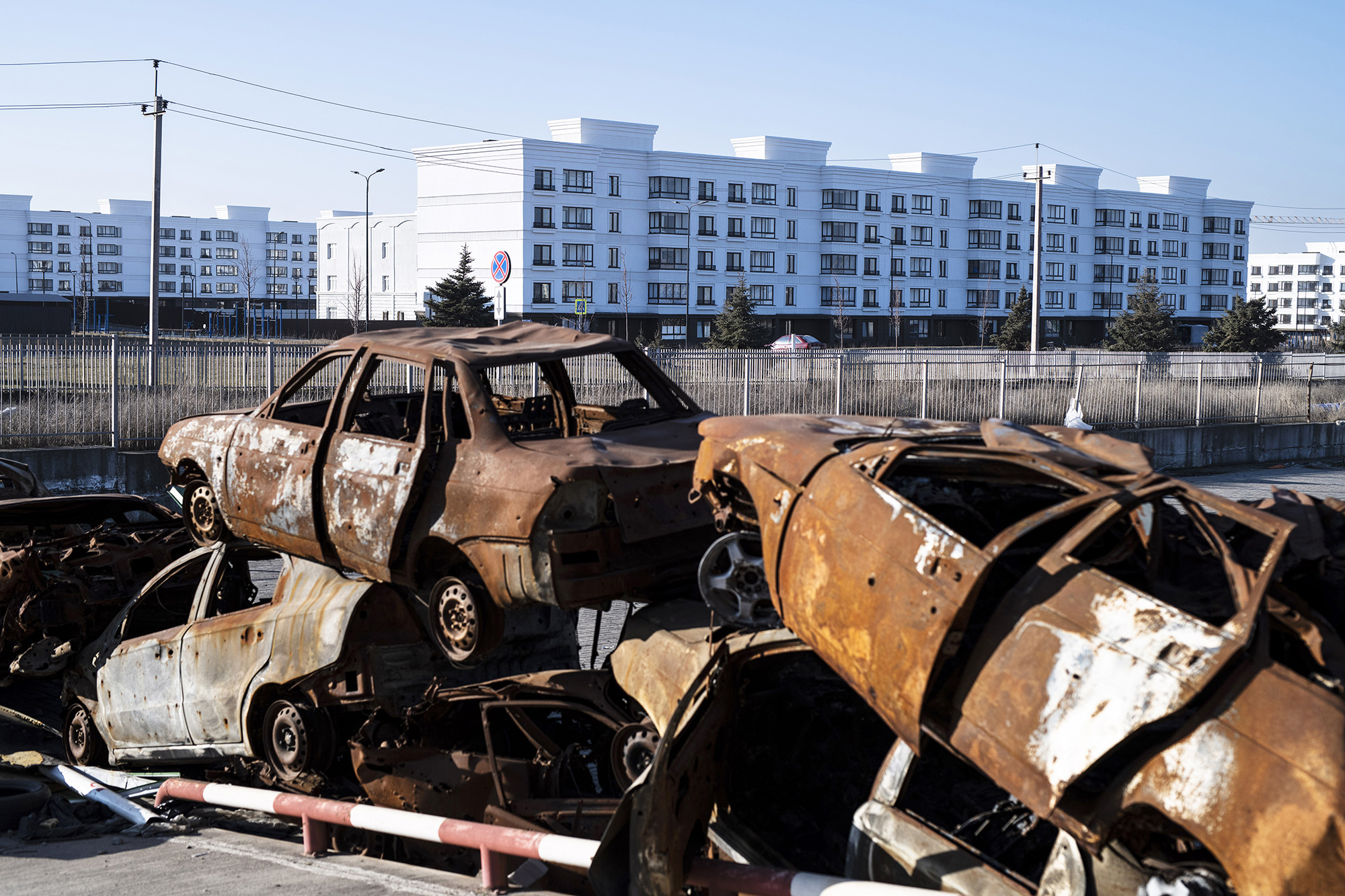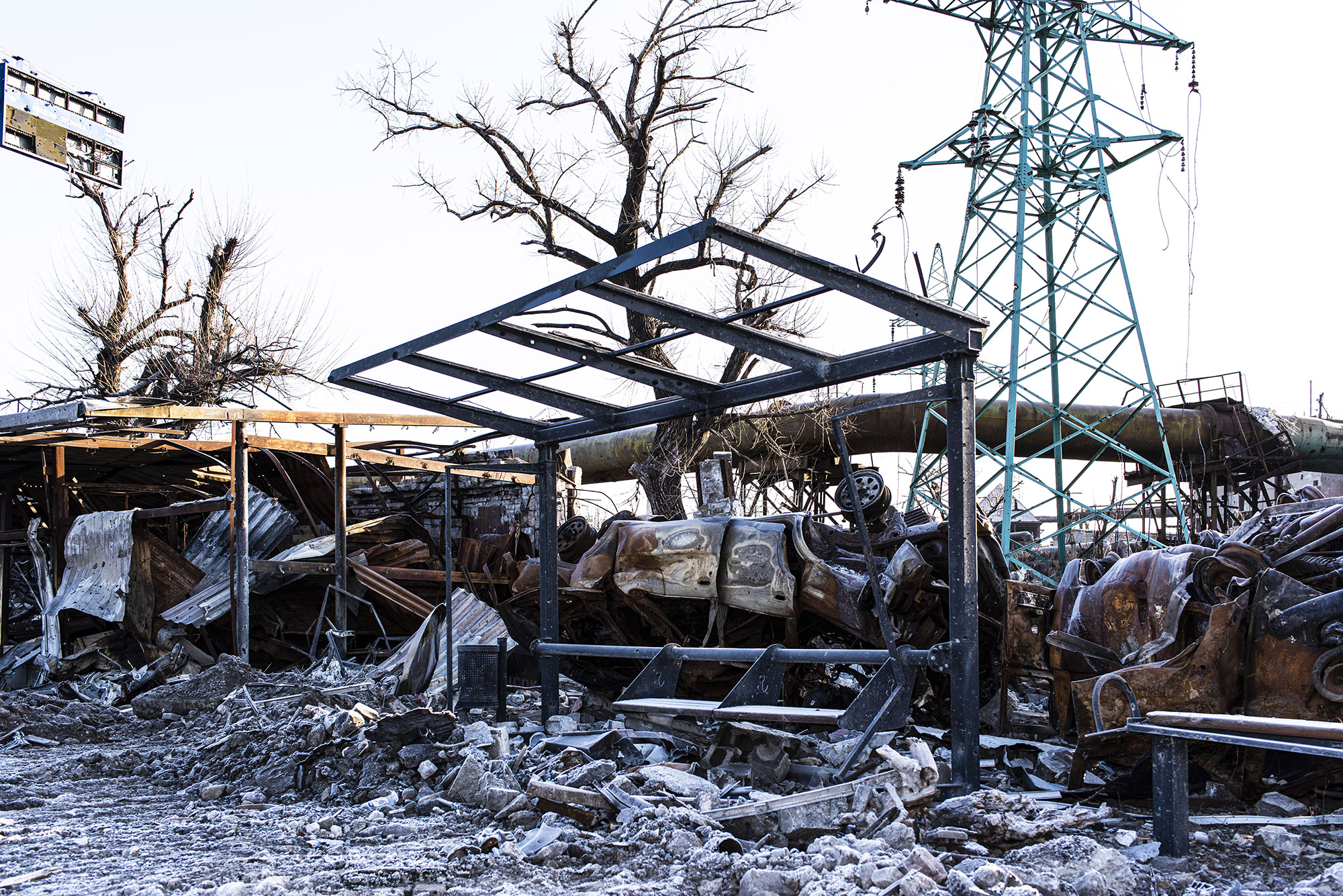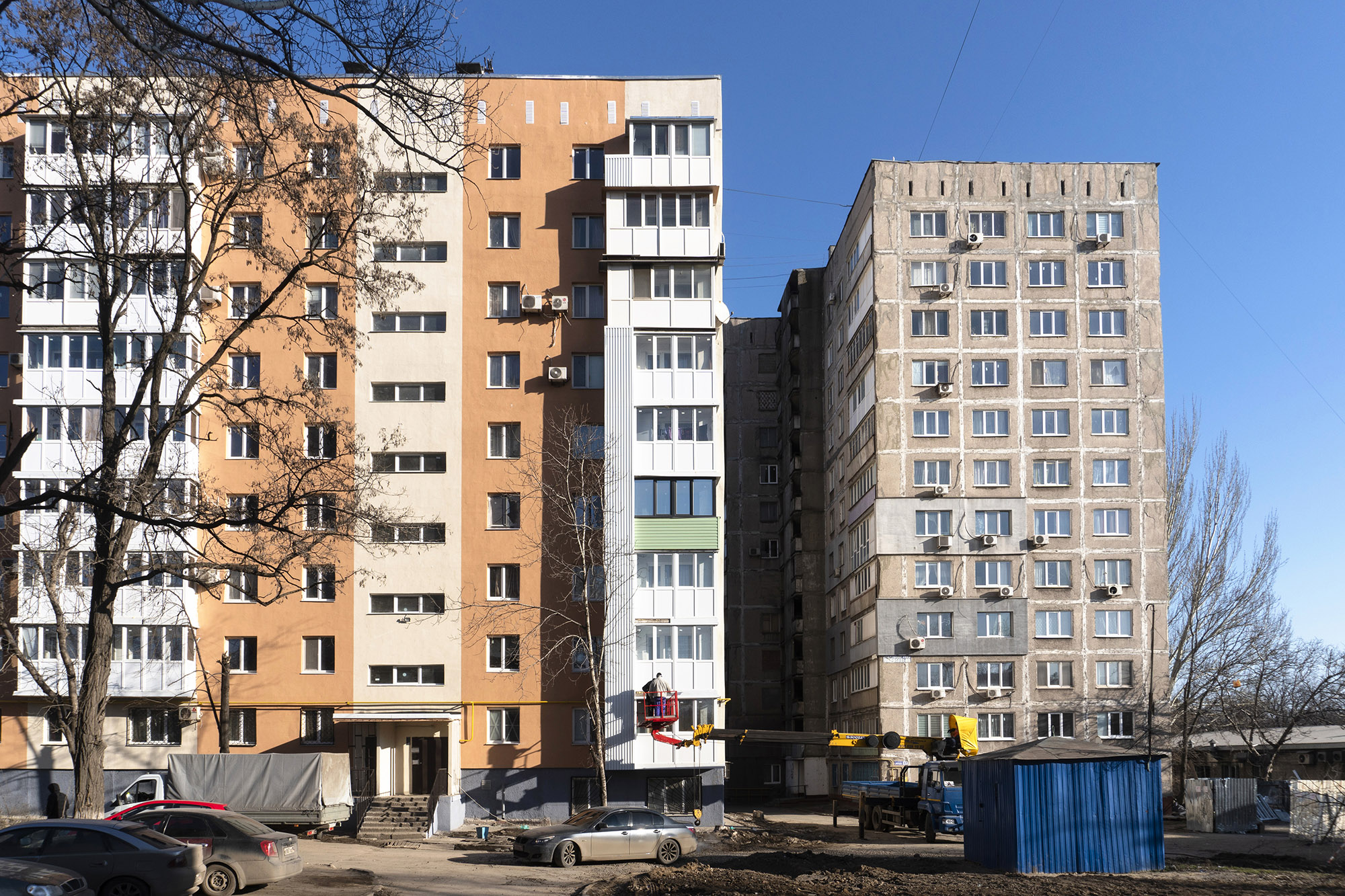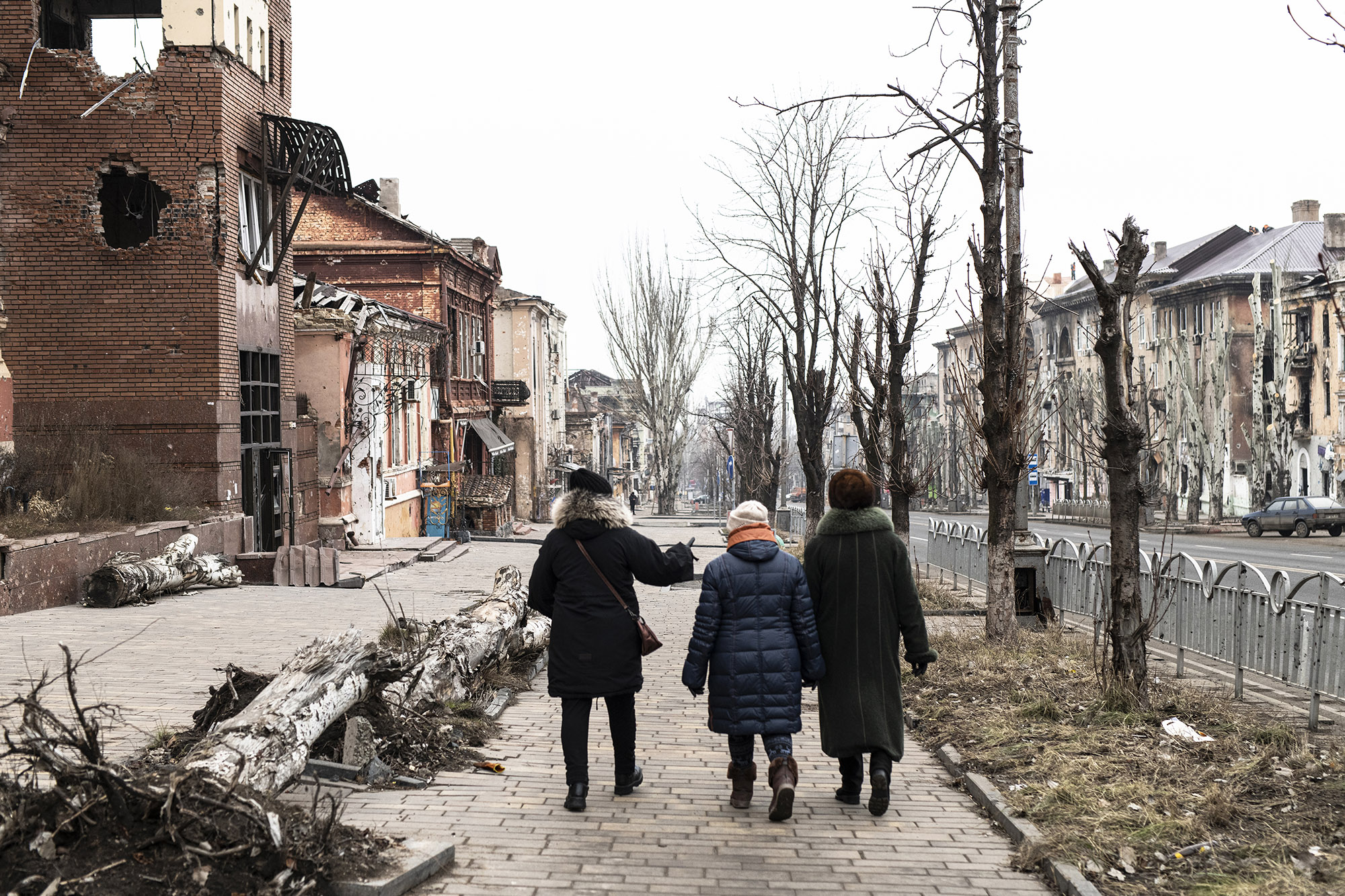EN
Present in Marioupol to relaunch my “Pics for Peace” photography workshop projects in the service of a future reconciliation between young people torn apart against (certainly) their will, I also worked on site for the German media Stern-Plus, the online version of the famous magazine.
The theme of the commission was to take stock of the city less than eight months after the retreat of Ukrainian “Azov” regiment.
If it is difficult to quantify the level of destruction, there is one thing that can be measured with the eye on a daily basis: the metamorphosis, the rebirth of the city.
Having walked around by foot or by taxi, alone or with the young people in the workshops, I can testify to the efficiency of the brigades of workers (more than 30,000, I am told), most of whom have come from very far away (Siberia and Central Asia).
The city has become a construction site where demolition, construction and renovation alternate.
Each building waiting to be razed or rebuilt is marked out, isolated by a fence to protect passers-by.
Double-glazed windows gleam on each saved façade.
Excavators crush the concrete while trucks remove the rubble in an incessant sweep that soils the wet pavements.
What I see of what is being accomplished in four months leaves me dreaming of what I will see when I return next June.
What will happen to the almost total reconstruction of the theatre of dramatic art?
Will the “Azovstal” metallurgical complex be the only place left unchanged since its total destruction?
Unless…
Unless the city undergoes what Donetsk, the capital of the oblast, has been undergoing since the summer of 2014, i.e. indiscriminate bombardment of the population by artillery donated by the Americans and the French.
Unless the port city once again becomes the scene of fierce fighting between the recapturing Ukrainians and the Russian resistance.
FR
Présent à Marioupol pour relancer mes projets d’ateliers de photographie « Pics for Peace » au service d’une future réconciliation entre des jeunesses déchirées contre (certainement) leur avis, j’ai aussi travaillé sur place pour le média allemand Stern-Plus, version en ligne du célèbre magazine.
Le thème de la commande étant de faire un état des lieux de la ville moins de huit mois après la retraite des troupes ukrainiennes.
S’il est difficile de quantifier la niveau de destruction, il est une chose qui se mesure à l’oeil au quotidien, c’est la métamorphose, le renaissance de la ville.
Pour m’être promené à pied ou en taxi, seul ou avec les jeunes des ateliers, je peux témoigner de l’efficacité des brigades d’ouvriers (plus de 30.000 me dit-on) venus de très loin pour la plupart (Sibérie et Asie Centrale).
La ville n’est plus qu’un chantier où alternent démolition, construction, rénovation.
Chaque bâtiment en attente d’être rasé ou refait est balisé, isolé par une palissade afin de protéger les passants.
Des fenêtres à double-vitrage rutilent sur chaque façade sauvegardée.
Les excavateurs broient le béton tandis que des camions évacuent les gravas en un balai incessant qui souille les chaussées humides.
Ce que je vois de ce qui s’accomplit en quatre mois, me laisse rêveur quant au constat que je ferai en revenant en juin prochain.
Où en sera la reconstruction quasi totale du théâtre d’art dramatique ?
Le complexe métallurgique « Azovstal» restera-t-il à ce moment le seul endroit resté inchangé depuis sa totale destruction ?
À moins, que…
À moins que la ville ne subisse ce que Donetsk, la capitale de l’oblast, subit depuis l’été 2014, c’est à dire des bombardements aveugles sur les populations par des pièces d’artillerie offertes par les Américains et les Français.
À moins que la cité portuaire ne redevienne le théâtre de farouches combats opposants des Ukrainiens en pleine reconquête et la résistance russe.
RU
Присутствуя в Мариуполе для возобновления моих проектов фотомастерской “Pics for Peace”, направленных на будущее примирение молодых людей, разлученных против (безусловно) их воли, я также работал на месте для немецкого СМИ Stern-Plus, онлайн-версии известного журнала.
Предмет заказа было подведение итогов жизни города спустя менее восьми месяцев после отступления украинских войск.
Если уровень разрушений трудно оценить количественно, то есть одна вещь, которую можно измерить на глаз ежедневно: метаморфоза, возрождение города.
Пройдя по городу пешком или на такси, один или с молодыми людьми в цехах, я могу засвидетельствовать эффективность бригад рабочих (более 30 000, как мне сказали), большинство из которых приехали издалека (из Сибири и Средней Азии).
Город превратился в строительную площадку, где чередуются снос, строительство и реконструкция.
Каждое здание, ожидающее сноса или реконструкции, обозначено, отгорожено забором, чтобы защитить прохожих.
На каждом сохраненном фасаде сверкают окна с двойным остеклением.
Экскаваторы дробят бетон, а грузовики убирают обломки, непрерывно подметая мокрые тротуары.
То, что я вижу за четыре месяца, заставляет меня мечтать о том, что я увижу, когда вернусь в июне следующего года.
Что будет с почти полной реконструкцией театра драматического искусства?
Останется ли металлургический комплекс “Азовсталь” единственным местом, оставшимся без изменений после его полного разрушения?
Если только…
Если только город не переживет то, что переживает Донецк, столица области, с лета 2014 года – беспорядочные обстрелы населения из артиллерии, подаренной американцами и французами.
Если только портовый город снова не станет ареной ожесточенных боев между восстанавливающими свои позиции украинцами и российским сопротивлением.
All pics by Éric Vazzoler / Zeitenspiegel / Stern-Plus






